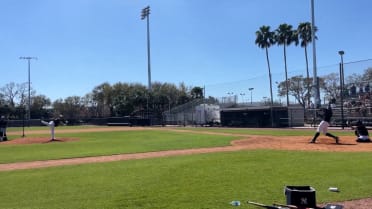Seaver stands above all as Mets monument
The sad news came on Thursday from Tom Seaver’s family and from the Hall of Fame that Seaver, who is 74 now, will be retiring from public life because of a diagnosis of dementia. And so many of the stories on this day referenced the loss of short-term memory for Seaver. But the story of the day in New York, and for Mets fans, was about all the long-term memory of what Seaver meant once at old Shea Stadium, and about the magic of a baseball season 50 years ago when Seaver and the ’69 Mets became one of the great sports stories of them all.
In the movie “Oh, God!” George Burns -- in the title role -- said, “The last miracle I did was the 1969 Mets.”
The Mets came into existence in 1962, and were the joke of baseball, losing 120 games and inspiring Jimmy Breslin to write a wonderful and hilarious book about them called “Can’t Anybody Here Play This Game?” But then Tom Seaver came along in 1967. Two years later his record was 25-7 as the Mets ultimately shocked the world and won it all. He would become known to Mets fans as “The Franchise,” only because he was. He mattered as much to the Mets in those years as Babe Ruth had once mattered to the Yankees. Because he made the Mets matter.
There will be so much celebration this season, around the Mets and at Citi Field, because it is the 50th anniversary of the Miracle Mets. But the one who won’t be around for any of it is the one who mattered the most, the pitcher who had the most to do with the Mets going from nothing to something; who ended up winning 311 games in the big leagues; who was the first Met into the Hall of Fame, with more than 98 percent of the vote, which was a record until Junior Griffey broke it, and then Mariano Rivera went into the Hall with 100 percent of the vote this year.
“My world was between the lines,” he told me when the All-Star Game came to Citi Field in 2013, and Seaver threw out the ceremonial first pitch before Matt Harvey, then the Mets’ star kid, threw the first pitch of the game.
Now his world becomes his beloved vineyard in Napa Valley. Later in his life he seemed as proud of his wine as he was his pitching. When he would talk about the vineyard he would be as excited as he once had been sitting in front of his locker at old Shea, putting down his crossword puzzle, and talking about the science of pitching, which of course he turned into art.
He was with the White Sox when he won his 300th game, in August of 1985, at Yankee Stadium of all places. Seaver was 40 by then. He pitched a complete game that day. After it was over, after he had heard a Yankee Stadium crowd chanting his name in the late innings, he was reminded that the final score had been 4-1 for old No. 41 and said, “Where do I buy a lottery ticket?” Mets fans knew better. The winning ticket had been him once.
When they closed Shea in 2008, it was Seaver and Mike Piazza, greatest Mets pitcher and greatest Mets catcher, walking to the outfield together and symbolically closing the outfield door out there. But the All-Star Game of '13 was really such a wonderful moment for him back in New York, even if it wasn’t Shea, because everyone in the crowd that night and everybody watching the game got to watch Seaver stand on a pitcher’s mound in the place I’ve always thought of as National League New York one more time.
He even milked the moment and worked the mound with what he called his “vineyard shoes” before delivering his pitch to David Wright. In that moment it wasn’t an All-Star crowd or a baseball crowd. It was a Mets crowd. It was 1969 again, and everybody who remembered what it was like in New York that summer, and into October, was young. And so was he.
As he made his way back upstairs from the field, I walked with him. So did his wife, Nancy, her hand in her husband’s.
“My world was the 60 feet, six inches between me and home plate,” he said that night. “It was the 90 feet between the bases. It was the distances on the outfield walls. I didn’t care about the ballpark as much as I remember the world between the lines.”
When he was asked about Harvey, who still had it all ahead of him then, he said, “I had my time. This is his.”
He went back home to his vineyard, and to his life with Nancy, after that All-Star Game. That is his world now. There is once again talk of building a Seaver statue outside Citi Field, and perhaps that will finally happen. But the real monument is in the imagination of Mets fans, the ones who were around in the late '60s, and then into the '70s, who do remember what it was like for them and in New York when Seaver was young. They remember everything.
Mike Lupica is a columnist for MLB.com.





